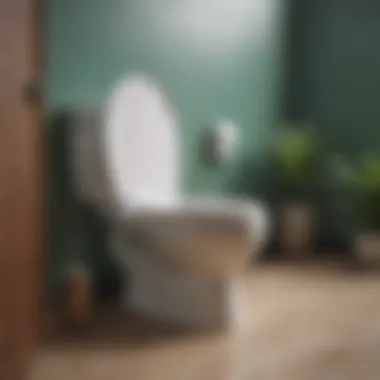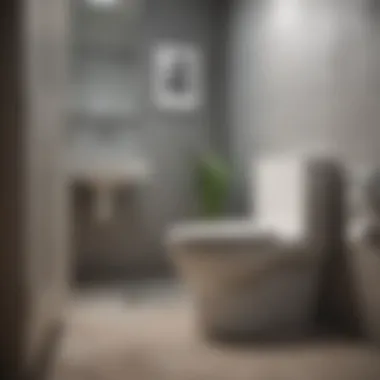Understanding and Resolving Toilet Bowl Block Issues


Intro
Toilet bowl blockages, though commonplace, can often catch homeowners off guard. Understanding the mechanics behind these issues can significantly enhance one's ability to deal with them. Blockages can arise from various factors such as improper waste disposal, buildup of minerals, or flawed plumbing designs. Each of these elements presents unique challenges that can complicate resolution efforts.
In this guide, readers will explore the causes and impacts of toilet blockages. It will also present effective solutions for managing and preventing these problems. This knowledge is essential not only for addressing immediate issues but also for maintaining the overall functionality of home plumbing systems.
Home Features
Understanding how home features can influence toilet system performance is vital. The placement and design of plumbing systems play a critical role in how effectively waste is evacuated. Factors such as pipe width, slope, and material type can all contribute to the likelihood of blockages.
Architectural Considerations
Architectural styles can affect plumbing layouts. Older homes may have more complex pipe systems that are prone to clogging. Newer constructions often prioritize efficiency, but this does not negate the risk of blockages altogether. Ensuring clear pathways within the plumbing system is an architectural necessity.
Unique Design Elements
Unique design elements, such as low-flow toilets, represent a dual-edged sword. While they provide environmental benefits, they also require careful consideration regarding what can be flushed. Users must be mindful of materials that these toilets are designed to handle, thus reducing the chance of clogs.
Common Causes of Blockages
Identifying common causes is fundamental for effective resolution. These include:
- Improper Disposal: Flushing non-biodegradable items can create immediate problems.
- Mineral Buildup: Hard water can leave deposits over time, restricting flow.
- Tree Roots: In older homes, invasive roots may compromise underground pipes.
To prevent blockages, homeowners should regularly inspect their plumbing systems. Assessing toilet function and performing routine maintenance can also mitigate risks.
"Prevention is always better than cure. Recognizing potential issues before they escalate is key to maintaining effective plumbing systems."
Effective Solutions
When faced with a blockage, knowing the right steps to take can save time and frustration. Here are practical approaches:
- Plunger Use: A traditional yet effective tool, a standard plunger can often dislodge blockages.
- Drain Snake: For more stubborn clogs, using a drain snake can provide access to deeper issues within the pipes.
- Enzyme-Based Cleaners: These products are designed to break down organic waste without damaging pipes.
Each of these solutions has its place, depending on the severity of the blockage.
Closure
Understanding toilet bowl block issues equips homeowners with the knowledge to tackle plumbing problems efficiently. By preventing potential blockages and knowing how to remedy existing ones, individuals can ensure their toilet systems remain functional. Remaining vigilant about the factors affecting toilet performance can minimize the occurrence of these bothersome interruptions in everyday life.
Prolusion to Toilet Bowl Blockages
Toilet bowl blockages are a frequent issue faced by homeowners. While often overlooked, understanding this problem is crucial for effective home maintenance. Toilet blockages can lead to unpleasant situations and costly repairs if not addressed promptly. This article delves into the nuances of toilet bowl block issues, providing insights that will allow homeowners to manage this common inconvenience more effectively.
Definition and Overview
A toilet bowl blockage occurs when the flow of water and waste through the plumbing is hindered. This can manifest in several ways. It may lead to slow drainage, overflowing of the toilet bowl, or even a complete inability to flush. The causes are often related to the buildup of waste, foreign objects, or issues within the plumbing system. Understanding the specifics of what constitutes a blockage can aid in the formulation of effective solutions.
Significance of Addressing Blockages
Addressing toilet blockages is vital for numerous reasons. First, they can significantly impact hygiene in the home. A blocked toilet not only creates a mess but also poses health risks due to the potential for bacterial growth. Second, regular attention to these issues can prevent more significant plumbing problems down the line.
In addition, there are financial implications to consider. Resolving minor blockages quickly can save money by avoiding extensive repairs later. Many homeowners often fail to recognize the symptoms until the problem escalates. Therefore, being proactive by understanding and monitoring toilet function is essential.
"Being mindful of your toilet's health can prevent costly repairs and maintain proper hygiene in your home."
To summarize, toilet bowl blockages are not just minor inconveniences. They are symptoms of underlying issues that, if neglected, can lead to serious complications. By understanding them, homeowners can maintain the efficiency of their plumbing systems.


Common Causes of Toilet Bowl Blockages
Toilet bowl blockages are more than just minor inconveniences; they can lead to more significant plumbing issues. Understanding the common causes of these blockages is vital for homeowners. By being aware of these elements, individuals can take proactive measures to prevent issues and maintain a smoothly functioning toilet system.
Excessive Toilet Paper Usage
One of the most prevalent reasons for toilet blockages is excessive toilet paper usage. Many people underestimate how much toilet paper they use during each visit. Overloading the toilet bowl with paper can lead to clogs, especially in older plumbing systems that cannot handle large volumes. It is crucial to educate household members on the appropriate amount of toilet paper to use.
For example, a few sheets at a time can help minimize risks. Additionally, using products labeled as "septic-safe" can be beneficial. Here are some tips:
- Use single-ply paper rather than multi-ply as it disintegrates easier.
- Encourage smaller toilet paper amounts for children or visitors.
- Discourage flushing other items such as wipes, even those marked as flushable.
Foreign Objects in the Bowl
Another factor contributing to blockages in toilet bowls is foreign objects. Items ranging from toys to personal hygiene products can create significant issues. Toilets are designed to handle human waste and toilet paper only. When other objects are introduced, they can obstruct the flow in the pipes.
A preventative strategy is to ensure that the toilet area is well supervised, especially for households with young children. If something unusual does get flushed, do not hesitate to address it quickly. Here are approaches to consider:
- Regularly check the toilet for unusual items, especially after guests.
- Limit the accessibility of small items that can easily be dropped into the bowl.
Worn Out Plumbing Parts
Over time, plumbing components can degrade. Worn out parts may not function as intended, leading to blockages. Issues like corrosion or buildup can restrict water flow, causing a toilet to clog more easily. Regular inspection of plumbing systems is advisable. Some signs of wear include:
- Frequent clogs that occur even with good usage practices.
- Leaking or visibly damaged components.
When these signs appear, it may be time to consider replacing aging parts or consult with a professional plumber.
Faulty Flush Mechanisms
A toilet relies on a properly functioning flush mechanism to clear waste. If components like flappers, fill valves, or flush levers are faulty, it can lead to incomplete flushes. This inadequacy can leave waste in the toilet bowl, gradually leading to blockages. Regular flushing mechanisms checks can help maintain efficient operation. Some maintenance tips include:
- Ensure the flapper seals tightly after flushing.
- Adjust the water level in the tank as needed to enhance flushing power.
By addressing the common causes of blockages, household members can reduce the likelihood of dealing with clogs effectively. Being proactive allows for efficient toilet use and can save homeowners time and costly plumbing repairs in the long run.
Identifying Symptoms of Blockages
When confronting the issue of toilet bowl blockages, recognizing symptoms is crucial. Identifying these signs early allows homeowners to address problems effectively, preventing further damage and inconvenience. This section will explore various symptoms of blockages and their implications, offering insights into maintaining optimal toilet function.
Slow Drainage Issues
Slow drainage is often the first noticeable sign of a blockage. Water takes more time than usual to flow down, which may frustrate users. Besides inconvenience, slow drainage can also indicate potential build-up of waste or foreign objects within the plumbing. When a toilet takes longer to drain, the homeowner should investigate.
To resolve this, a plunger may initially be used to restore proper flow. If the issue persists, a manual auger can be beneficial for deeper clogs. Regularly checking for slow drainage can save considerable trouble in the long term.
Overflowing Toilet Bowls
An overflowing toilet bowl is one of the more alarming signs of a blockage. It can lead to water damage and unpleasant messes. This condition is typically the result of a severe clog, where water cannot find a clear passage. In such cases, it is important to act quickly to minimize damage.
Turning off the water supply to the toilet will stop further overflow while cleaning the area is necessary. If the blockage is not resolved after basic measures, professional intervention may be required. Overflowing toilets must be treated as urgent problems.
Unpleasant Odors
Unpleasant odors coming from the toilet are not just unpleasant; they can signal deeper issues. A persistent smell may indicate decaying waste trapped in the pipes or an incomplete flush resulting from blockages. It is not just a nuisance; these odors can compromise the home environment and indicate hygiene concerns. Regular cleaning and inspection are essential for maintaining a fresh toilet experience.
Culmination
By paying attention to these signs — slow drainage, overflowing bowls, and unpleasant odors — homeowners can address blockages at an early stage. Being knowledgeable about these symptoms ensures prompt action, thus preventing more severe plumbing problems down the line. This awareness is an essential aspect of effective toilet maintenance.


Tools and Techniques for Unclogging Toilets
To effectively resolve toilet bowl block issues, it is crucial to understand the tools and techniques available for unclogging toilets. Having the right tools can save time and reduce stress when faced with a blockage. These techniques address various types of clogs, ensuring homeowners are equipped with practical solutions.
Plungers and Their Effectiveness
Plungers are often the first go-to tool for unclogging a toilet. Their efficiency lies in the mechanism of creating pressure and suction that dislodges obstructions. A standard cup plunger, characterized by its rubber suction cup, works best on flat surfaces. Alternatively, a flange plunger, which features an extended rubber flap, is specifically designed for toilets. This design allows for a better seal, enhancing its effectiveness.
To use a plunger effectively, follow these steps:
- Ensure the toilet bowl has enough water to cover the rubber part of the plunger.
- Align the plunger over the drain hole, ensuring it's sealed tightly.
- Push down and pull up in quick succession, maintaining the seal.
Repeat this motion for about 15 seconds. If successful, the water should start to drain away. It is essential not to flush the toilet during this process, as it may lead to overflow. Plungers are often effective for minor blockages caused by toilet paper or waste.
Manual Augers for Deeper Clogs
In cases where plungers fail, a manual auger may provide the necessary solution. Manual augers, also called plumbing snakes, are tools designed to reach deeper into the plumbing system. They consist of a long, flexible coil that can navigate through bends in pipes. This allows for the removal of obstructions that a plunger cannot reach.
To use a manual auger:
- Insert the auger into the toilet bowl until it reaches the obstruction.
- Rotate the handle to extend the coil deeper into the trap.
- Continue rotating until you feel resistance.
- Pull the auger back, bringing along any debris it may have dislodged.
This method is often effective for removing foreign objects or clogs caused by excessive waste buildup. While this tool may require practice to master, its ability to tackle deeper clogs makes it invaluable.
Chemical Drain Cleaners: Usage and Precautions
Chemical drain cleaners can be a quick fix for toilet bowl blockages. These products often contain corrosive ingredients that can dissolve clogs in moments. However, their use demands caution. Improper application can damage plumbing materials and create harmful fumes.
If choosing to use chemical drain cleaners:
- Read the label carefully to ensure it's safe for toilet use.
- Avoid mixing different products, as it may lead to dangerous reactions.
- Follow safety instructions, such as using gloves and protective eyewear.
- Limit use to occasional problems, rather than regular maintenance.
In summary, while chemical cleaners can offer immediate relief, they pose risks that need consideration. Over-reliance on these substances can lead to long-term issues in a plumbing system.
Effective unclogging requires knowledge of various tools and methods. Accessing the right tool based on the type of blockage is essential to successfully restoring function without inflicting damage.
Understanding these tools will enhance your ability to manage toilet blockages effectively. This proactive approach prevents future inconveniences, ensuring a well-functioning bathroom.
Preventive Measures to Avoid Blockages
Preventive measures are essential in managing toilet bowl blockages. Understanding the significance of these approaches can greatly enhance the functionality of your toilet and minimize future hassles. Regularly implementing specific strategies can save time, money, and stress associated with plumbing problems.
Educating Household Members
Education is a fundamental step in preventing toilet blockages. Each household member must understand what should and should not be flushed. Often, individuals may not recognize that items like feminine hygiene products, wipes, or excessive amounts of toilet paper can cause significant clogs. Encouraging everyone to adopt proper disposal habits is key to maintaining a clear plumbing system.
Conduct family discussions or create informative signage in the bathroom as daily reminders. A collective effort in educating household members will cultivate an awareness that helps in preventing blockages.
Regular Maintenance Checks
Routine maintenance checks play a crucial role in the longevity of your toilet. It’s advisable to inspect various components such as flush mechanisms, seals, and water levels. Ensuring these elements function correctly can help you catch potential problems before they escalate.
- Check for leaks around the base of the toilet.
- Confirm that the water shuts off completely when the tank fills.
- Assess the flushing power; weak flushes may indicate clogging issues.
Set a regular schedule for these checks, perhaps on a seasonal basis. This will foster a proactive approach toward plumbing maintenance.
Using Recommended Products


Using the right products can significantly reduce the incidence of blockages. This involves selecting toilet paper that disintegrates easily in water and finding safe cleaning supplies that do not damage plumbing.
Opt for environmentally friendly options where possible. They tend to be less harsh on the plumbing system and offer effective cleaning without the risk of creating additional issues. Furthermore, consider using preventative solutions like enzyme-based drain cleaners on a periodic basis to maintain clarity in pipes.
When to Call a Professional Plumber
Addressing toilet bowl blockages can often be managed independently. However, there are situations when enlisting a professional plumber becomes essential. Recognizing the right time to reach out for expert help is a crucial aspect of maintaining your toilet system without unnecessary strain.
Signs of Severe Clogs
When a clog becomes pervasive, it may signal an issue beyond standard blockages. Several indicators suggest that it is time to contact a plumber:
- Repeated Clogging: If you notice that the toilet frequently clogs, this may indicate an underlying plumbing issue, such as a collapsed pipe or a major obstruction in the sewer line.
- Persistent Backflow: Situations where water from the toilet bowl returns after flushing can be alarming. This often signifies that sewage is not draining correctly, possibly pointing to a more significant problem.
- Gurgling Sounds: Unusual noises from the toilet or other drains can suggest that air is trapped within the plumbing system, which might indicate a significant blockage that affects more than just the toilet.
- Multiple Fixtures Affected: If clogs appear not just in the toilet but also in sinks or showers, this could be a sign of a clog in the main sewer line, requiring professional intervention.
Identifying these signs as early as possible can save homeowners from larger, more costly repairs later.
Complex Plumbing Diagnostics
Certain plumbing issues require advanced diagnostic skills that go beyond basic unclogging techniques. Here are some scenarios where professional expertise is invaluable:
- Video Inspection: Plumbers often use video cameras to examine the insides of the pipes. This technology allows them to identify the exact location and cause of a blockage, which can save time and effort in resolving complex issues.
- Access to Specialized Tools: Trained professionals have access to tools like hydro-jetters, which clear more stubborn clogs that typical household tools may fail to address.
- Understanding Local Codes: Plumbing regulations differ based on location. Professional plumbers ensure that all repairs comply with local building codes, preventing potential fines or issues during property inspections.
- Comprehensive Knowledge: Experienced plumbers can recognize a variety of issues not easily identified by untrained individuals. Their expertise enables them to foresee future issues that may arise from current blockages.
Ultimately, while some blockages can be resolved with household tools, knowing when to seek professional help can safeguard against complicated plumbing dilemmas.
Understanding Toilet Bowl Design and Functionality
To understand how to resolve toilet bowl block issues effectively, one must first comprehend the design and functionality of the toilet itself. Toilets are intricate systems that combine various elements working together to manage waste efficiently. Recognizing these components helps in addressing blockages when they occur. Ultimately, this knowledge aids in preventing issues that can lead to expensive repairs or significant inconvenience.
Anatomy of a Toilet Bowl
A standard toilet bowl consists of several key parts that contribute to its overall function:
- Bowl Shape: The bowl is usually designed to funnel waste towards the drain hole. Its shape influences how waste moves and can affect the chances of clogging.
- Drain Hole: Located at the base, this is where waste exits the bowl. Its diameter and positioning play a crucial role in drainage speed and effectiveness.
- Trapway: This S-shaped pipe connects the bowl to the plumbing. Its design helps to maintain water in the bowl, which prevents odors from rising.
- Flushing Rim: The rim around the top of the bowl allows water to flow evenly during a flush, ensuring a complete wash of the bowl’s interior.
Understanding these elements is vital for anyone looking to manage toilet maintenance effectively. Knowing how each part interacts can help in diagnosing and preventing blockages.
How Toilets Function
Toilets function through a relatively simple process that combines gravity and water flow to manage waste:
- Filling the Tank: After a flush, the tank fills with water from the supply line. This water is crucial for the next flush.
- Initiating the Flush: When the flush handle is pressed, it lifts a flapper, allowing water to rush from the tank into the bowl.
- Creating Flush Pressure: The water movement generates a siphoning action, pulling the waste down through the trapway.
- Refilling the Bowl: After the waste exits, the trapway keeps a small amount of water in the bowl to create a seal against odors.
- Refilling and Resetting: Once the tank empties, a float mechanism triggers the refill process, preparing the system for the next use.
This cycle showcases the delicate balance of mechanics and materials in toilet design. Knowing how a toilet operates can illuminate common problems and their solutions. A blockage may disrupt this seamless process, leading to issues that require immediate attention. A clear understanding of toilet functionality allows for quicker diagnosis and resolution of such problems, enhancing overall maintenance efforts.
Environmental Impact of Toilet Bowl Blockages
Toilet bowl blockages may seem like a minor inconvenience in everyday life, yet their environmental implications are significant. Understanding these impacts not only serves to highlight the broader consequences of neglecting plumbing maintenance but also encourages more responsible behavior among homeowners and renters alike. Dealing with blockages swiftly can prevent unnecessary water waste and reduce the strain on sewage systems.
When blockages occur, toilets often require multiple flushes, leading to excessive water usage. Each flush consumes around 1.6 gallons on average, which can add up quickly when a toilet struggles to clear a clog. To illustrate, a single blockage that requires three extra flushes results in almost five gallons of additional water wasted. This strain on resources can be particularly problematic in areas facing water scarcity.
Furthermore, the better we manage our toilets, the less likely we are to experience overflow incidents, which can lead to wastewater seeping into the environment. Understanding this context emphasizes the importance of recognizing and maintaining proper toilet functioning as a means of environmental stewardship.
Epilogue
Toilet bowl block issues pose significant inconveniences that can disrupt daily life. Addressing these problems effectively not only enhances personal comfort but also improves the longevity of plumbing systems. Throughout this article, we have discussed various aspects surrounding blockages, including their causes, symptoms, and preventive measures. Such comprehensive insights are invaluable for homeowners, enabling them to take proactive steps in maintaining their toilets.
Summary of Best Practices
- Limit Toilet Paper Use: It is wise to minimize excessive toilet paper use. Opting for thinner sheets can reduce the likelihood of clogs.
- Educate Household Members: Ensuring that everyone in the household understands which items can safely be flushed can mitigate the risks associated with foreign objects.
- Routine Maintenance: Regular inspections and cleaning can help identify potential blockages early, allowing for timely interventions before serious issues arise.
- Be Mindful of Flush Mechanisms: Checking the flush system's efficiency can prevent malfunction and subsequent blockage. Replace worn parts when necessary.
Future Considerations for Homeowners
Homeowners should remain vigilant about evolving plumbing technologies and products that can enhance toilet performance. Innovations in toilet designs and plumbing materials could significantly reduce the chances of future blockages.
Moreover, understanding local plumbing codes and regulations can be beneficial when making renovations or repairs. Homeowners should also consider adopting eco-friendly practices, as these contribute to sustainability while maintaining efficient flush systems. Staying informed on water conservation techniques can complement these efforts, as it aligns with preventing any adverse environmental impacts.



